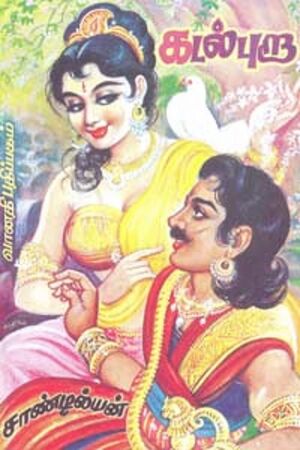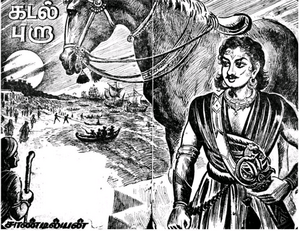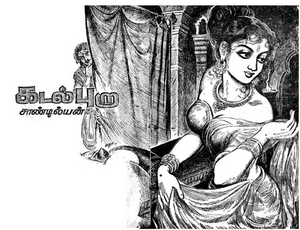Kadal Pura: Difference between revisions
(submitted for review) |
No edit summary |
||
| Line 4: | Line 4: | ||
{{Read Tamil|Name of target page=கடல்புறா|Title of target page=கடல்புறா}} | {{Read Tamil|Name of target page=கடல்புறா|Title of target page=கடல்புறா}} | ||
''Kadal Pura'' (Sea Pigeon) (1974) was a historical adventure novel by [[ | ''Kadal Pura'' (Sea Pigeon) (1974) was a historical adventure novel by [[Chandilyan]]. The novel was set against the backdrop of Karunakara Thondaiman's victory over Kalinga, the protagonist of the short epic Kalingathuparani. | ||
== Publication == | == Publication == | ||
''Kadal Pura'' was written as a series in [[ | ''Kadal Pura'' was written as a series in [[Kumudam]] magazine in 1974 and was published as a book by Vanathi publication. | ||
== Data, Evidences == | == Data, Evidences == | ||
In the foreword to this story, for the proof, | In the foreword to this story, for the proof, Chandilyan quoted the references of Bhojan's ''Yukti Kalpataru'' - a book on the wooden vessel structure, Professor Radha Kumud Mookerji’s ''Indian Shipping'', Dr. Majumdar's ''Suvarnadvipa'' - a book on the history of Kadaram and the genealogy of the Shailendras, [[K. A. Neelakanta Sastry]]’s notes on the Kadaram war during the reign of Veerarajendra and the historical books from Dr. S. Krishnaswami Aiyangar and Shri. P.T. Srinivasa Iyengar. | ||
Anabayan crowned as Kulothunga-I was engaged in resolving the conflict for the throne of Sri Vijaya empire and maintaining peace there from 1063 to 1070 C.E. In the year 1077, a delegation of Tamils led by Devakulo reached China. Chandilyan noted that Devakulo refers to Kulothunga. Chandilyan included Kalingathuparani also as a proof'','' which portrays the story of Kulothunga's chief commander Karunakara Thondaiman's conquest of Kalinga. | |||
== Historical Background == | == Historical Background == | ||
Kulothunga Chola I (1070-1122) was referred in the inscriptions as | Kulothunga Chola I (1070-1122) was referred in the inscriptions as Anabayan. According to ''Kalingathuparani'', he was born to Rajaraja Narendra, the eastern Chalukya king who ruled Venginadu and Chola princess, in the Gangaikonda Cholapuram palace, and was adopted by Rajendra Chola as his successor. But prince Anabayan did not get the throne after the death of Rajendra Chola. Adhirajendran, another son of Rajendra Chola, assumed the power in 1070 C.E. under the name of Kulothunga Chola. Anabayan might have been adopted because Adhirajendran was ill. Adhirajendran ruled the kingdom for very few years only. | ||
During the reign of Kulothunga I, the boundaries of the Chola kingdom were vast. So there were battles with all the frontier countries. Internally, there were conflicts between the right hand caste and the left hand caste groups. But Kulothunga I is regarded as one of the greatest kings of Chola period. With powerful commanders like Prince Rajendra Chola, Arayan Kalingaraya, Senapati Irungovel, Arayan Sayanthan Karunakara Pallavan Udayan Adittan, Arulmozhi Rajadhiraja Vanathirayar, Azhagiya Manavala Nambi and Raja Raja Maduranthakan, Kulothunga I conquered Chalukyanadu, Cheranadu, Eelam and Vengi nadus in the battles and subjugated them. | During the reign of Kulothunga I, the boundaries of the Chola kingdom were vast. So there were battles with all the frontier countries. Internally, there were conflicts between the right hand caste and the left hand caste groups. But Kulothunga I is regarded as one of the greatest kings of Chola period. With powerful commanders like Prince Rajendra Chola, Arayan Kalingaraya, Senapati Irungovel, Arayan Sayanthan Karunakara Pallavan Udayan Adittan, Arulmozhi Rajadhiraja Vanathirayar, Azhagiya Manavala Nambi and Raja Raja Maduranthakan, Kulothunga I conquered Chalukyanadu, Cheranadu, Eelam and Vengi nadus in the battles and subjugated them. | ||
Kulothunga I fought two Kalinga battles. When the Kalingas tried to capture Vengi, which was close to the Chola kingdom, the Chola forces led by Prince Vikrama Chola with the consorts of Kalingaraya and Karunakara Thondaiman, defeated the Kalingas. The second Battle of Kalinga was fought under the leadership of Karunakara Pallavan, Arayan Kalingaraya and Arayan Rajanarayanan. | Kulothunga I fought two Kalinga battles. When the Kalingas tried to capture Vengi, which was close to the Chola kingdom, the Chola forces led by Prince Vikrama Chola with the consorts of Kalingaraya and Karunakara Thondaiman, defeated the Kalingas. The second Battle of Kalinga was fought under the leadership of Karunakara Pallavan, Arayan Kalingaraya and Arayan Rajanarayanan. Kalingathuparani composed by Jayankondar portrays at length about this battle. Kalinga was said to be completely destroyed in the battle. It is speculated that this battle happened in 33rd year of coronation of Kulothunga Chola I (1102 C.E.). | ||
Karunakara Thondaiman conquered the Kalinga ruled by the king Ananthavarman Chodagangan (1077-1150). Ananthavarman ruled the eastern Ganganadu, one of the three Kalinga kingdoms. Ganga king was born to Rajaraja Devan and Rajasundari, daughter of Chola emperor Veerarajendra. Kalinga invasion by the son-in-law of Kulothunga Chola (also referred to be grandson by some historians) might have been the result of conflicts within the family. | Karunakara Thondaiman conquered the Kalinga ruled by the king Ananthavarman Chodagangan (1077-1150). Ananthavarman ruled the eastern Ganganadu, one of the three Kalinga kingdoms. Ganga king was born to Rajaraja Devan and Rajasundari, daughter of Chola emperor Veerarajendra. Kalinga invasion by the son-in-law of Kulothunga Chola (also referred to be grandson by some historians) might have been the result of conflicts within the family. | ||
There is evidence that Kulothunga Chola intervened in the dispute of the Sri Vijaya Empire. He was associated with the Sri Vijaya and Khmer empires. According to K.A. Neelakanta | There is evidence that Kulothunga Chola intervened in the dispute of the Sri Vijaya Empire. He was associated with the Sri Vijaya and Khmer empires. According to K.A. Neelakanta Sastri, there is evidence that Kulothunga Chola sent ambassadors to China in 1077 C.E. As per the inscriptions, Suryavarman, Khmer king who built Angkor Wat temple in 1114 C.E., gifted rare diamonds to Kulothunga Chola. Kulothunga Chola going to Sri Vijaya with his forces in 1063 C.E. and settling the throne dispute is evidenced through the inscription carved by Veerarajendra in his seventh year of coronation (1063 C.E.). This inscription states that the Chola armies conquered Kadaram and returned it to the king who bowed down. According to scholars, Kulothunga might have been in Sri Vijaya empire until 1067 C.E. Sri Vijaya empire enjoyed good relations with Kulothunga Chola. There is evidence that King Sri Vijaya funded the renovation of Nagai Chudamani Vihara built by Rajaraja Chola. | ||
== Synopsis == | == Synopsis == | ||
Protagonist of the story is the commander of the Chola army, Karunakara Thondaiman. For fighting against the tyranny of Jayavarman in Sri Vijaya kingdom, his younger brother Gunavarman seeks the help of Cholas. Along with his daughter Kanchana Devi, Gunavarman moves to Kalinga's Palur Perundurai. Kalinga’s king is a friend of Sri Vijaya King Jayavarman. So Jayavarman plans to kill Gunavarman with the help of Kalinga king. When this news reaches Chola king Veerarajendra, he directs Karunakara Pallava to Kalinga to rescue Gunavarman and his daughter Kanchana Devi. Veerarajendra also gives a peace note and orders him to deliver it to Bhima, king of South Kalinga. | Protagonist of the story is the commander of the Chola army, Karunakara Thondaiman. For fighting against the tyranny of Jayavarman in Sri Vijaya kingdom, his younger brother Gunavarman seeks the help of Cholas. Along with his daughter Kanchana Devi, Gunavarman moves to Kalinga's Palur Perundurai. Kalinga’s king is a friend of Sri Vijaya King Jayavarman. So Jayavarman plans to kill Gunavarman with the help of Kalinga king. When this news reaches Chola king Veerarajendra, he directs Karunakara Pallava to Kalinga to rescue Gunavarman and his daughter Kanchana Devi. Veerarajendra also gives a peace note and orders him to deliver it to Bhima, king of South Kalinga. | ||
But Bhima does not honor the peace note and places Karunakara in jail. He also plans to conquer sea dominance from the Cholas. Karunakara escapes from Kalinga after multiple adventures. Kulothunga I ( | But Bhima does not honor the peace note and places Karunakara in jail. He also plans to conquer sea dominance from the Cholas. Karunakara escapes from Kalinga after multiple adventures. Kulothunga I (Anabayan), son of Veerarajendra helps him. Anabayan's companion Amir, an Arab, and his teacher Aguda, a Chinese, stand with him. With the help of Aguda, Karunakaran learns the techniques of sea battle and transforms the ship that he received as a gift from Aguda, into a warship called the Kadal Pura (Sea Pigeon), and performs various feats to save the Chola merchants from the pirates. Karunakara meets Manjalazhagi on mohini island. She falls in love with him. On account of his duty and in memory of Kanchana Devi, he is unable to accept Manjalazhagi, but regrets not being able to forget her. He then accidentally saves Kanchana from the pirates. He captures Sri Vijaya empire and seats Gunavarman on its throne. At the request of Jayavarman, who lost the battle, Veerarajendra Chola arranges marriages between Manjalazhagi and Karunakara Pallava. | ||
== Literary Significance == | == Literary Significance == | ||
''Kadal Pura'' touches very lightly the Chola’s Kalinga battles, Chola’s intervention in the politics of Sri Vijaya empire, and the political problems of Sri Vijaya empire. This novel was mostly influenced by British pirate novels. This novel elaborates on naval adventures. The landscape descriptions are entirely imaginary in this novel. While comparing with other | ''Kadal Pura'' touches very lightly the Chola’s Kalinga battles, Chola’s intervention in the politics of Sri Vijaya empire, and the political problems of Sri Vijaya empire. This novel was mostly influenced by British pirate novels. This novel elaborates on naval adventures. The landscape descriptions are entirely imaginary in this novel. While comparing with other Chandilyan novels, this is the least historically oriented one. Since the adventures of Ulysses, the imaginary adventures on imaginary landscapes are spoken in European literature. The contribution of this novel was to bring them into Tamil. | ||
== References == | == References == | ||
* [http://tamilaivugal.org/TamilPhd/TamilKallooriAayvugal?collegeResearchId=370 Historical view on | * [http://tamilaivugal.org/TamilPhd/TamilKallooriAayvugal?collegeResearchId=370 Historical view on Chandilyan's Novels - N. Ganesan, Bharathidasan University, 2004] | ||
* [https://powsdouble.blogspot.com/2013/07/blog-post_3189.html Foreword to Kadal Pura] | * [https://powsdouble.blogspot.com/2013/07/blog-post_3189.html Foreword to Kadal Pura] | ||
* [https://www.tamildigitallibrary.in/book-detail.php?id=jZY9lup2kZl6TuXGlZQdjZU7kxyy#book1/ Cholas - K. A. Neelakanta | * [https://www.tamildigitallibrary.in/book-detail.php?id=jZY9lup2kZl6TuXGlZQdjZU7kxyy#book1/ Cholas - K. A. Neelakanta Sastri] | ||
[[Category:English Content]] | [[Category:English Content]] | ||
[[Category:Ready for Review En]] | [[Category:Ready for Review En]] | ||
{{Standardised-en}} | |||
Revision as of 23:53, 24 May 2022
இந்தப் பக்கத்தை தமிழில் வாசிக்க: கடல்புறா
Kadal Pura (Sea Pigeon) (1974) was a historical adventure novel by Chandilyan. The novel was set against the backdrop of Karunakara Thondaiman's victory over Kalinga, the protagonist of the short epic Kalingathuparani.
Publication
Kadal Pura was written as a series in Kumudam magazine in 1974 and was published as a book by Vanathi publication.
Data, Evidences
In the foreword to this story, for the proof, Chandilyan quoted the references of Bhojan's Yukti Kalpataru - a book on the wooden vessel structure, Professor Radha Kumud Mookerji’s Indian Shipping, Dr. Majumdar's Suvarnadvipa - a book on the history of Kadaram and the genealogy of the Shailendras, K. A. Neelakanta Sastry’s notes on the Kadaram war during the reign of Veerarajendra and the historical books from Dr. S. Krishnaswami Aiyangar and Shri. P.T. Srinivasa Iyengar.
Anabayan crowned as Kulothunga-I was engaged in resolving the conflict for the throne of Sri Vijaya empire and maintaining peace there from 1063 to 1070 C.E. In the year 1077, a delegation of Tamils led by Devakulo reached China. Chandilyan noted that Devakulo refers to Kulothunga. Chandilyan included Kalingathuparani also as a proof, which portrays the story of Kulothunga's chief commander Karunakara Thondaiman's conquest of Kalinga.
Historical Background
Kulothunga Chola I (1070-1122) was referred in the inscriptions as Anabayan. According to Kalingathuparani, he was born to Rajaraja Narendra, the eastern Chalukya king who ruled Venginadu and Chola princess, in the Gangaikonda Cholapuram palace, and was adopted by Rajendra Chola as his successor. But prince Anabayan did not get the throne after the death of Rajendra Chola. Adhirajendran, another son of Rajendra Chola, assumed the power in 1070 C.E. under the name of Kulothunga Chola. Anabayan might have been adopted because Adhirajendran was ill. Adhirajendran ruled the kingdom for very few years only.
During the reign of Kulothunga I, the boundaries of the Chola kingdom were vast. So there were battles with all the frontier countries. Internally, there were conflicts between the right hand caste and the left hand caste groups. But Kulothunga I is regarded as one of the greatest kings of Chola period. With powerful commanders like Prince Rajendra Chola, Arayan Kalingaraya, Senapati Irungovel, Arayan Sayanthan Karunakara Pallavan Udayan Adittan, Arulmozhi Rajadhiraja Vanathirayar, Azhagiya Manavala Nambi and Raja Raja Maduranthakan, Kulothunga I conquered Chalukyanadu, Cheranadu, Eelam and Vengi nadus in the battles and subjugated them.
Kulothunga I fought two Kalinga battles. When the Kalingas tried to capture Vengi, which was close to the Chola kingdom, the Chola forces led by Prince Vikrama Chola with the consorts of Kalingaraya and Karunakara Thondaiman, defeated the Kalingas. The second Battle of Kalinga was fought under the leadership of Karunakara Pallavan, Arayan Kalingaraya and Arayan Rajanarayanan. Kalingathuparani composed by Jayankondar portrays at length about this battle. Kalinga was said to be completely destroyed in the battle. It is speculated that this battle happened in 33rd year of coronation of Kulothunga Chola I (1102 C.E.).
Karunakara Thondaiman conquered the Kalinga ruled by the king Ananthavarman Chodagangan (1077-1150). Ananthavarman ruled the eastern Ganganadu, one of the three Kalinga kingdoms. Ganga king was born to Rajaraja Devan and Rajasundari, daughter of Chola emperor Veerarajendra. Kalinga invasion by the son-in-law of Kulothunga Chola (also referred to be grandson by some historians) might have been the result of conflicts within the family.
There is evidence that Kulothunga Chola intervened in the dispute of the Sri Vijaya Empire. He was associated with the Sri Vijaya and Khmer empires. According to K.A. Neelakanta Sastri, there is evidence that Kulothunga Chola sent ambassadors to China in 1077 C.E. As per the inscriptions, Suryavarman, Khmer king who built Angkor Wat temple in 1114 C.E., gifted rare diamonds to Kulothunga Chola. Kulothunga Chola going to Sri Vijaya with his forces in 1063 C.E. and settling the throne dispute is evidenced through the inscription carved by Veerarajendra in his seventh year of coronation (1063 C.E.). This inscription states that the Chola armies conquered Kadaram and returned it to the king who bowed down. According to scholars, Kulothunga might have been in Sri Vijaya empire until 1067 C.E. Sri Vijaya empire enjoyed good relations with Kulothunga Chola. There is evidence that King Sri Vijaya funded the renovation of Nagai Chudamani Vihara built by Rajaraja Chola.
Synopsis
Protagonist of the story is the commander of the Chola army, Karunakara Thondaiman. For fighting against the tyranny of Jayavarman in Sri Vijaya kingdom, his younger brother Gunavarman seeks the help of Cholas. Along with his daughter Kanchana Devi, Gunavarman moves to Kalinga's Palur Perundurai. Kalinga’s king is a friend of Sri Vijaya King Jayavarman. So Jayavarman plans to kill Gunavarman with the help of Kalinga king. When this news reaches Chola king Veerarajendra, he directs Karunakara Pallava to Kalinga to rescue Gunavarman and his daughter Kanchana Devi. Veerarajendra also gives a peace note and orders him to deliver it to Bhima, king of South Kalinga.
But Bhima does not honor the peace note and places Karunakara in jail. He also plans to conquer sea dominance from the Cholas. Karunakara escapes from Kalinga after multiple adventures. Kulothunga I (Anabayan), son of Veerarajendra helps him. Anabayan's companion Amir, an Arab, and his teacher Aguda, a Chinese, stand with him. With the help of Aguda, Karunakaran learns the techniques of sea battle and transforms the ship that he received as a gift from Aguda, into a warship called the Kadal Pura (Sea Pigeon), and performs various feats to save the Chola merchants from the pirates. Karunakara meets Manjalazhagi on mohini island. She falls in love with him. On account of his duty and in memory of Kanchana Devi, he is unable to accept Manjalazhagi, but regrets not being able to forget her. He then accidentally saves Kanchana from the pirates. He captures Sri Vijaya empire and seats Gunavarman on its throne. At the request of Jayavarman, who lost the battle, Veerarajendra Chola arranges marriages between Manjalazhagi and Karunakara Pallava.
Literary Significance
Kadal Pura touches very lightly the Chola’s Kalinga battles, Chola’s intervention in the politics of Sri Vijaya empire, and the political problems of Sri Vijaya empire. This novel was mostly influenced by British pirate novels. This novel elaborates on naval adventures. The landscape descriptions are entirely imaginary in this novel. While comparing with other Chandilyan novels, this is the least historically oriented one. Since the adventures of Ulysses, the imaginary adventures on imaginary landscapes are spoken in European literature. The contribution of this novel was to bring them into Tamil.
References
- Historical view on Chandilyan's Novels - N. Ganesan, Bharathidasan University, 2004
- Foreword to Kadal Pura
- Cholas - K. A. Neelakanta Sastri
⨮ Standardised-en
Please do not write any content below this line. This section is only for editing templates & categories.



